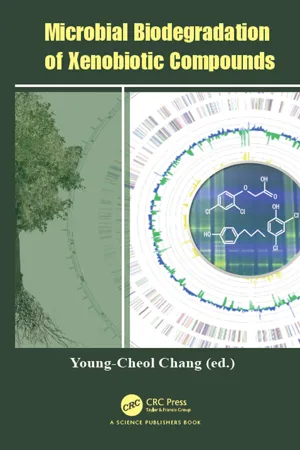
- 242 pages
- English
- ePUB (mobile friendly)
- Available on iOS & Android
Microbial Biodegradation of Xenobiotic Compounds
About This Book
Microbial Biodegradation of Xenobiotic Compounds examines and collects the recent information on the bioremediation technologies around the world. This book focuses on methods to decrease pollutants created by anthropogenic activities, industrial activities, and agricultural activities. This book answers some of the questions about – how to reduce contaminants? And whether there is a possibility of converting these pollutants in to useful energy by advanced biotechnological methods?
The book combines present obtainable data with the expert knowledge of researchers from all over the world covering different aspects of environmental biotechnology and microbiology. It covers basic concepts of bioremediation and various methods involved in the bioremediation process, and provides specific chapters on the role of different genes and enzymes involved in microbial bioremediation process. It also gives special attention to heavy metal bioremediation by microalgae and the mechanisms involved during the degradation process. Recent innovative technologies about converting toxic pollutants in to useful energy like bioplastics and electricity are also discussed by specialist authors. Various chapters address the bioremediation of pesticides in soil using microbial metabolites, and molecular aspects of biodegradation which cover topics including identification of novel genes through the metagenomic approach and bioremediation using fungal laccase enzymes.
Frequently asked questions
Information
Table of contents
- Cover
- Title Page
- Copyright Page
- Table of Contents
- Preface
- 1. Degradation of Aromatic Compounds and their Conversion into Useful Energy by Bacteria
- 2. Bioaugmentation and Biostimulation Remediation Technologies for Heavy Metal Lead Contaminant
- 3. Water Bioremediation using Aquatic Plants
- 4. Heavy Metal Bioremediation by Microalgae: Mechanisms and Applications
- 5. Contaminant Removal and Energy Recovery in Microbial Fuel Cells
- 6. Microbial Removal of Dye Stuffs
- 7. Bioremediation of Organic Xenobiotics from Wastewater: A Review
- 8. Fungal Laccase Mediated Bioremediation of Xenobiotic Compounds
- 9. Genes Involved in Microbial Bioremediation
- 10. Bioremediation of Heavy Hydrocarbons and Polycyclic Aromatic Hydrocarbons: Environmental Implications and Technical Constraints
- 11. Identification of a Novel Gene Through the Metagenomic Approach to Degrade the Targeted Pollutant
- 12. Interactions Between Nonpolar Compounds and Soil Organic Carbon Under Low Redox Potentials: Implications for Bioavailability
- Index